Best Management Practices (BMPs) to Prevent the Introduction and Spread of Invasive Species
Developing Best Management Practices for Invasive Species
Land managers are facing increasing pressure from invasive plants, animals, insects and plant pathogens on the lands they own and manage. Furthermore, many land management practices used for forestry, agriculture, wildlife and recreational habitat management involve periodic disturbances that favor the introduction and/or spread of invasive species.
Most natural resource managers are familiar with the concept of Best Management Practices or BMPs uses in forestry as guidelines for recommended practices to protect water and soil resources during management operations such as timber harvests. As invasive species threaten more lands in the South, land managers can use BMPs for invasive species by developing a proactive approach to invasive species identification, documentation and control on their properties. To accomplish this, landowners must develop an awareness of the potential for the introduction and/or spread of invasive species as related to “normal use or management on their lands”.
Key BMPs for invasive species management (adapted from Wisconsin Council of Forestry 2009)
- Learn to identify invasives common in your area.
- Inventory invasives when developing plans for management activities, and assess the extent of invasive species on and near the property by scouting, locating and documenting infestations.
- Develop response/control plans to treat invasives when found.
- Educate property users about invasive species, their impacts, and ways to prevent their introduction and spread.
- Require all property users to follow BMP practices.
- In planning for activities on the property, limit the potential introduction and spread of invasive species.
- Properly dispose of soil, seeds, plant parts or invertebrates found during inspection and cleaning.
- Consider responses of invasive species to land management activities that result in disturbances
- Use as practical, construction and maintenance materials (mulch, gravel, topsoil, etc.) that are free of invasive species
 |
| Landowner and consulting forester examining Japanese climbing fern in a stand scheduled for timber harvest. |
This information highlights invasive plant, animal, insect and plant pathogen issues that landowners might encounter and provides guidelines for preventing their introduction and spread. Landowner and consulting forester examining Japanese climbing fern in a stand scheduled for timber harvest.
Many landowners unknowingly introduce and spread invasive plants on their lands through management practices they implement. Practices, from traditional silviculture to wildlife enhancement and agricultural land-use all influence invasive plant growth, production, and dispersal. During the planning stage for any management project, document existing invasive species and develop plans with your forester, contractors and vendors to keep from spreading existing invasives or introducing new ones.
General Principles to Reduce the Impact of Invasive Plants
- Learn to identify invasive plants and incorporate their management into any land-use plan.
- Prevent introduction of invasive plants to uninfested sites. This critical component is one of the most cost-effective methods of management.
- Contain and treat new invasive plants or those not yet well established. Controlling small infestations is more effective and economical than trying to control well-established, rapidly spreading infestations.
- Minimize transport of invasive plants from infested to uninfested areas. Cleaning vehicles and equipment is the most effective method of prevention.
- Use weed free soil, fill, and mulch in construction projects. Monitor sites where potentially infested materials were used.
- Minimize soil disturbance. Invasive plants often prefer disturbed ground, don’t disturb soil unless it is necessary. Monitor disturbed sites through several growing seasons for invasives.
- Maintain desirable species: Establishing and maintaining competitive, desirable plants along roadsides and disturbed areas prevents or slows establishment of invasive plants.
Land Management Practices
Harvest Activities
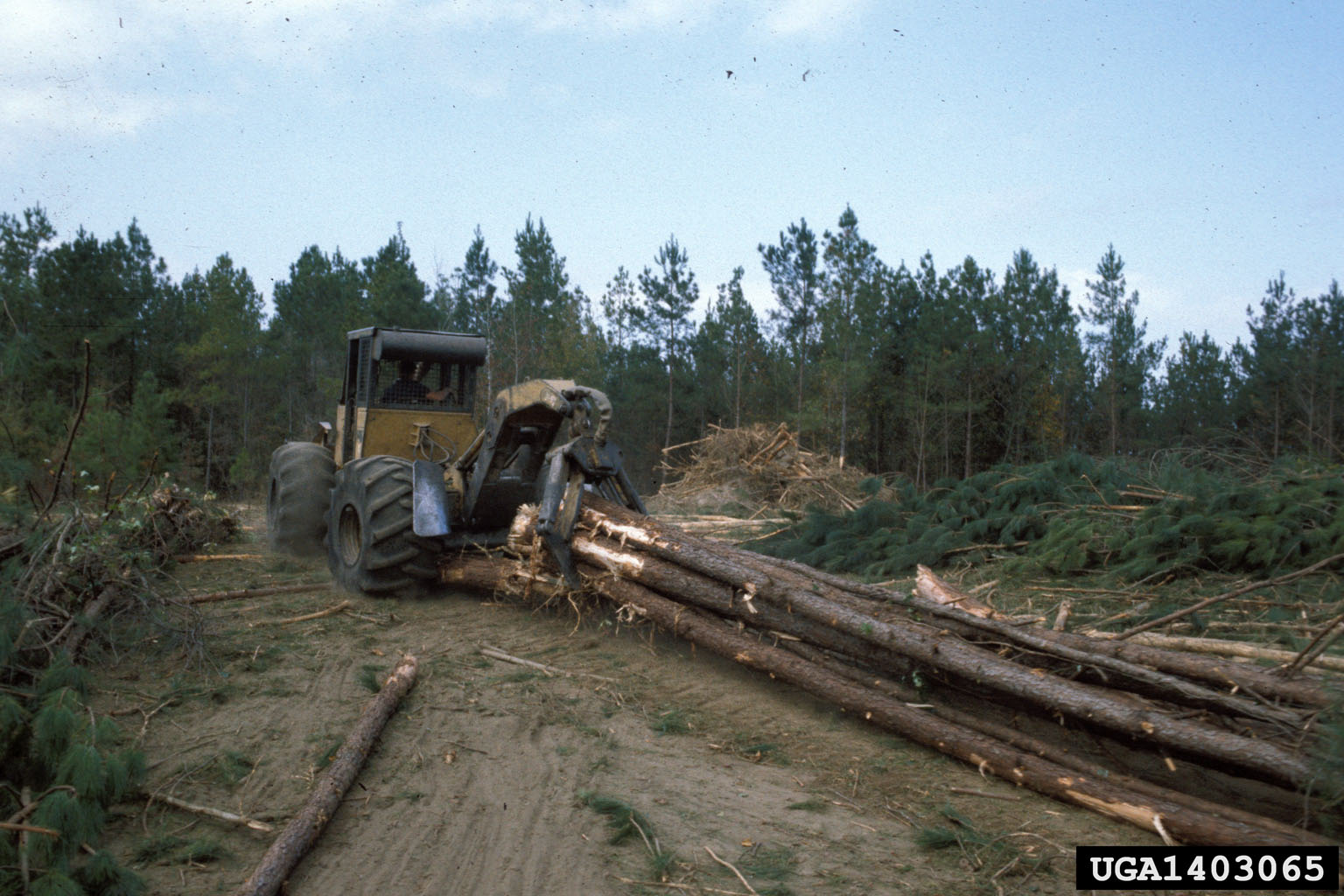 |
| Skidding can spread invasives across the harvest tract. |
Harvest activities include practices in which trees are harvested, such as regeneration cuts (for example, shelterwood, seed tree, and group selection), thinning operations, or clear cuts.
Habitat Alterations:
- Soil disturbance
- Increased light to understory or forest floor
- Mechanical damage
- Use of off-site equipment
Prescribed Fire
 |
| Prescribed fire can be used to control certain invasive species and spread others. |
Prescribed fire is the practice of using fire, intentionally set, to obtain certain management objectives. Often prescribed fire is used to inhibit establishment of undesirable species or to set back succession. The use of prescribed fire also includes creation and maintenance of fire breaks.
Habitat Alterations:
- Creation of bare soil
- Initial release of nutrients
- Kill or top kill of under and mid-story vegetation
- Increased light to understory or forest floor
- Soil disturbance (fire breaks)
- Use of off-site equipment
Internal Roads and Stream Crossings
 |
| Road construction uses off-site materials which may contain invasives. |
Roads are often built within a parcel of land to enable the owner/manager to move equipment and reach remote areas. Included within this category is the creation and maintenance of internal roads and stream crossings.
Habitat Alterations:
- Soil disturbance
- Open canopy
- Increased light to understory or forest floor
- Off-site material
- Use of off-site equipment
- Potential wetland disturbance
Mechanical Site Preparation
 |
| Site preparation creates bare soil and high light environment conducive to invasive establishment and spread. |
The practice of site preparation (or site prep) manipulates the ground layer to achieve a better microclimate for seedling establishment and growth. Site prep often follows a clearcut treatment and precedes planting. Common mechanical site prep treatments are: bedding, chopping, and disking.
Habitat Alterations:
- Exposes bare mineral soil
- Increased light to understory or forest floor
- Use of off-site equipment
- Removal of native vegetation
- Damage and alteration to root zone (compaction, rutting, drainage)
Tree Planting
 |
| Tree planting equipment may harbor invasive seeds or plant material. |
Tree planting includes the practices involved in planting seedlings. Seed bed preparation treatments, such as scalping and sub-soiling, and seedling planting are included within this category.
Habitat Alterations:
- Soil disturbance
- Mechanical damage
- Use of off-site equipment
- Off-site material
Release Treatments (Intermediate Treatments)
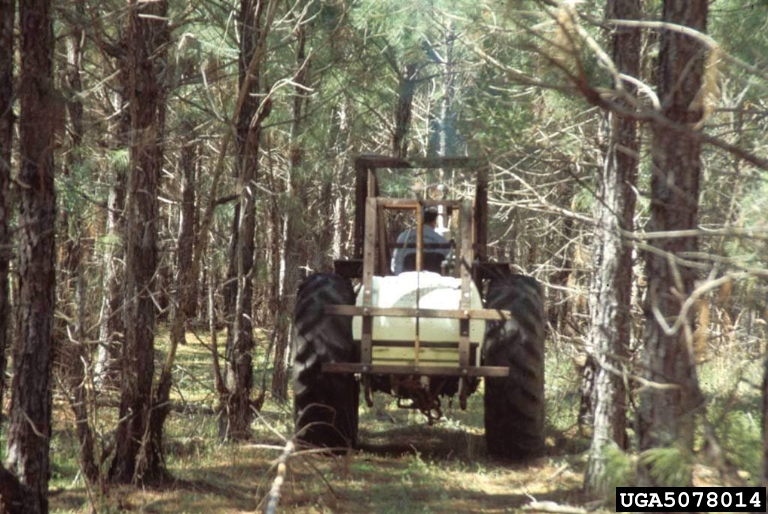 |
| Release treatments create high light environments conducive to establishment of invasives. |
Release treatments are used to free small trees from competition from undesirable vegetation. Treatments include herbicide, mowing, cutting, and fire.
Habitat Alterations:
- Increased light to understory or forest floor
- Midstory removal/thinning
- Understory damage/disturbance
- Soil disturbance
- Off site equipment
Special Considerations
Pine Straw Production
 |
| Pine straw production |
Many pine stands are managed for pine straw production. The needles that are naturally shed from pine trees are raked, baled, and sold as pine straw mulch. Pine straw production involves managing stands for optimum straw production, removing understory vegetation with herbicide and/or fire, collecting (raking) the straw, and making bales.
Often practices such as prescribed fire, mowing, and herbicide treatments are used in production areas. Stand alterations include soil disturbance, removal of understory and midstory, and increased light to the forest floor. Bales and equipment from infested stands can foster the widespread distribution of invasive plants.
Wildlife Enhancement
 |
| Wildlife food plot |
Wildlife enhancement involves any practice that can improve or enhance the wildlife habitat on a land, such as food plot installation, fertilization, and selective thinning and planting. This is a varied category but can include aspects of other silvicultural practices. Wildlife enhancement practices are a common avenue for invasive plant introductions, either via contaminated equipment or intentional planting. Areas to monitor for any invasive plants are camps, food plots, and other areas used.
Streamside Management Zones (SMZ)
 |
| Forest stream |
These areas are protected because of water quality and erosion concerns. They can be refuges for invasive plants which can spread into adjacent lands. Since SMZs are adjacent to drainages, streams and rivers, invasive plants that favor wet areas, streamsides, or bottomlands are likely to be present. Conduct annual inspections to detect establishment of invasives, particularly, following flooding events.
Land Use Conversion
 |
| Newly planted pine stand invaded by kudzu |
This category covers practices used when converting lands previously under cultivated agriculture or pasture into trees. A different suite of invasive plants can become problems in areas undergoing land use conversion. Established invasive plant populations or viable seedbanks may exist in surrounding agricultural fields or pastures. Fencerows may serve as a harbor for these invasives. A plant that was a minor pest in the previous land use may not be inhibited by the current management practices and suddenly expand its population drastically.
General Guidelines for Risk Reduction: Early Detection Through Monitoring
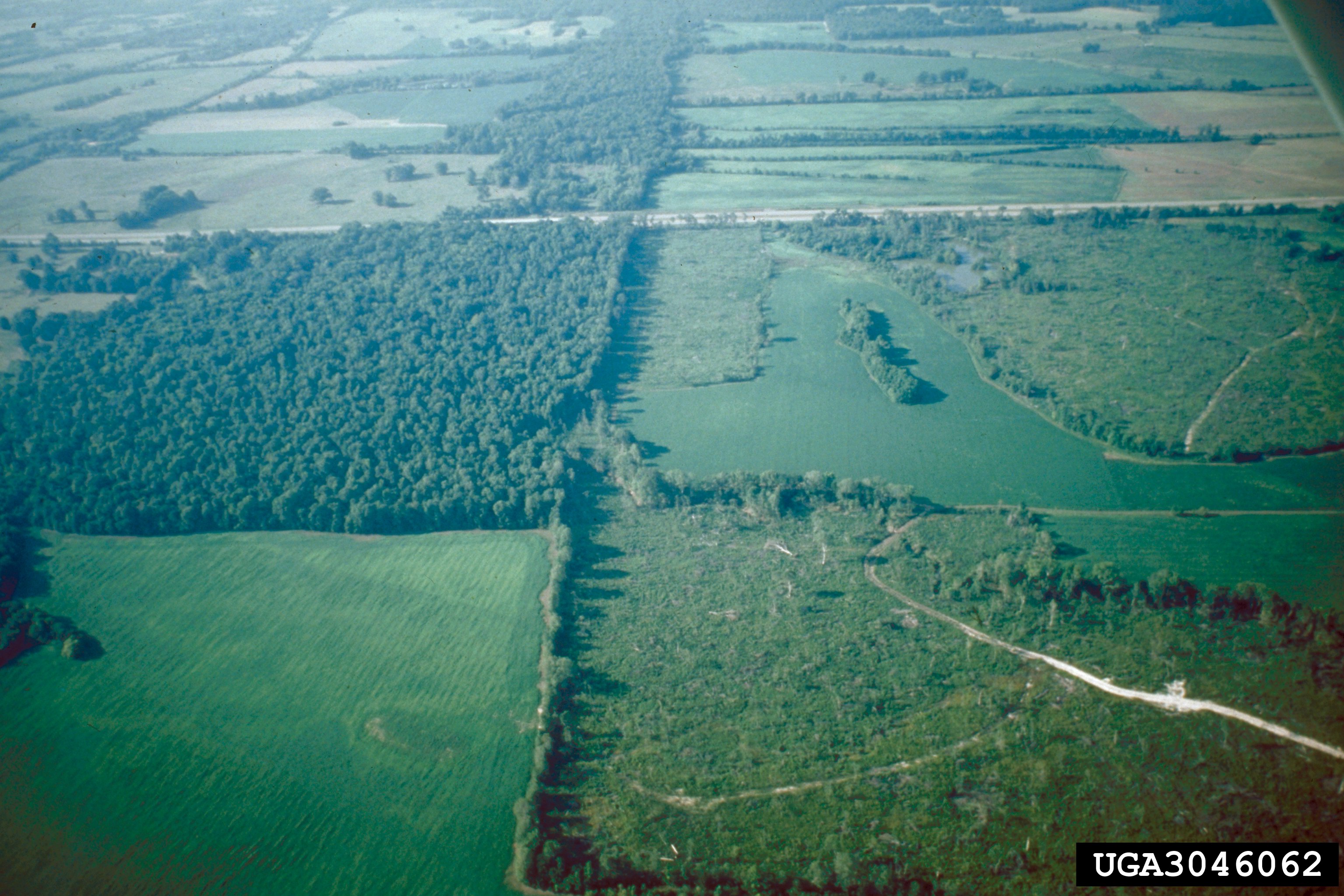 |
| Harvest tract with SMZs and fencerows |
- Monitor disturbed habitats for newly established invasive plants.
- Sites to monitor include food plots, cut-over lands, roadsides, stream sides, recently flooded areas, storm damaged areas, internal roads and trails, firebreaks, burned areas rights-of-way, and fencerows.
- Mark known infestations on a map and flag them in field for easy re-location.
- Search the surrounding areas for any “satellite” infestations and mark them as well.
Best Management Practices for Activities Involving Soil Disturbance
 |
| Road maintenance |
- Before starting ground-disturbing activities, inventory invasive plant infestations both on-site and in the adjacent area (fencerows, SMZs, ROWs, etc.).
- Begin activities in uninfested areas before operating in infested areas.
- Use uninfested areas for staging, parking and cleaning equipment. Avoid or minimize all types of travel through infested areas, or restrict to those periods when spread of seed or plant reproductive parts are least likely.
- Minimize soil disturbance and retain desirable vegetation in and around the area to the maximum extent possible.
- When possible, to suppress growth of invasive plants and prevent their establishment, retain relatively closed canopies.
- Do not blade roads or pull ditches where new invaders are found, if possible.
- When it is necessary to conduct soil work in infested roadsides or ditches, schedule activity when seeds or propagules are least likely to be viable and to be spread.
- Quarantine soil from infested area to prevent off-site spread.
- Monitor disturbed areas for at least three growing seasons following completion of activities. Provide for follow-up treatments based on inspection results.
Best Management Practices Involving Off-site Material and Equipment
- Invasive plants can be introduced and spread by moving infested equipment, sand, gravel, borrow, fill and other off-site material.
- Determine the need and identify sites where equipment can be cleaned. Seeds and plant parts need to be collected when practical and incinerated. Remove mud, dirt, and plant parts from project equipment before moving it into a project area and clean all equipment before leaving the project site, if operating in infested areas.
- Inspect material sources at site of origin to ensure that they are free of invasive plant material before use and transport. Treat infested sources for eradication, and strip and stockpile contaminated material before any use.
- Inspect and document the area where material from treated infested sources is used annually for at least three years after project completion to ensure that any invasive plants transported to the site are promptly detected and controlled.
- Maintain stockpiled, uninfested material in a weed-free condition.
- Incorporate invasive plant prevention into road work layout, design, and decisions.
- Minimize roadside sources of seed that could be transported to other areas.
- Periodically inspect system roads and rights-of-way for invasion. Inventory and mark infestations and schedule them for treatment.
- Avoid working in infested areas if possible. Postpone work until invasive plants have been eliminated from the site.
- Perform road maintenance such as road grading, brushing, and ditch cleaning from uninfested to infested areas to help prevent moving seeds and plant material from infested areas into adjacent uninfested areas.
- Clean road graders and other equipment immediately after operating in infested areas. Clean all dirt and plant parts from the top and underside of mower decks.
Best Management Practices for Revegetation
 |
| Applying mulch for soil stabilization |
 |
| Native longleaf wiregrass stand |
- Revegetate all disturbed soil, except on surfaced roads, in a manner that optimizes plant establishment for that specific site, unless ongoing disturbance at the site will prevent establishment of invasive plants.
- When revegetating areas that were previously dominated by invasive plants, try to achieve at least 90% control of the invasive before attempting restoration.
- Use local seeding guidelines and appropriate mixes, but realize that many species previously recommended for this purpose are now presenting invasive problems. Use native material where appropriate and available. Revegetation may include planting, seeding, fertilization, and mulching.
- Monitor and evaluate success of revegetation in relation to project plan.
Best Management Practices for Prescribed Burns
Carefully plan all prescribed burns and identify and map invasives found in the burn tract. Determine the interactions between the invasives and the planned burn.
- Before conducting a prescribed burn, apply for a burning permit as required.
- Avoid intense burns that remove forest floor litter which may expose soil.
- Use natural or existing barriers (e.g., roads, streams, lakes) where possible, or wet lines for firelines where bladed or plowed firelines will erode soil and degrade water quality.
- Check fire plows and tractors before use and clean as necessary prevent introduction of invasives.
- Plow fire lines in areas where invasives are not present before plowing in areas infested with invasives to prevent spread. Clean equipment before leaving site.
- Scout in the growing season following the burn for new invasives in the burned stand and breaks.
- Use mowing or other practices that do not expose soil as alternatives to blading or disking for maintaining firebreaks.
Other Invasive Species Concerns
 |
| Firewood stacks |
Many properties are leased or used for hunting, fishing, camping and other recreational uses. Movement of firewood, boats, ATVs, equipment used for habitat management, food plot establishment and other activities can unintentionally introduce invasives. Landowners should meet with all property users to infom them of invasive species concerns and BMPS required to prevent their introduction. Ask users to report invasive sightings.
One important key is to use only local firewood as many serious invasive insects and diseases can move on firewood from infested areas.
 |
| Emerald ash borer |
Emerald Ash Borer has a broad distribution in the United States and Canada and was recently discovered in East Tennessee in July 2010. The widespread distribution is primarily due to the transportation of infested ash commodities such as nursery stock, unprocessed logs, firewood, and other ash tree products. Federal and state quarantines in infested states now regulate transport of these products.
 |
| Asian long-horned beetle |
The Asian long-horned beetle is known to attack at least 18 species of hardwood trees including maple, birch, horse chestnut, willow, elm, ash, and black locust.
 |
| Adult Sirex woodwasp |
The Sirex woodwasp, while not yet found in the South, can attack loblolly, slash and shortleaf pines. The female drills into the wood and inserts a toxic mucous and the fungus Amylostereum areolatum along with her eggs. The mucus prevents anti-fungal toxins from being formed at the site of infection. The fungus grows in the wood causing it to dry out and the trees die in a few weeks or months.
 |
| Thousand cankers disease symptoms |
Thousand cankers disease has been found in many Western States. The first confirmation of the beetle and fungus within the native range of black walnut was in Tennessee (July 2010). The potential damage to eastern forests could be great because of the widespread distribution of eastern black walnut, the susceptibility of this tree to the disease, and the capacity of the fungus and beetle to invade new areas.
These serious invaders can easily move on firewood from infested areas. Require those using your lands to follow these BMPs.
Best Management Practices for Firewood & Wood Products
- Buy firewood near where you will burn it.
- Wood that looks clean and healthy can still have tiny insect eggs, or microscopic fungi spores, that will start a new and deadly infestation. Always leave it at home, even if you think the firewood looks fine.
- Aged or seasoned wood is still not safe. Just because it is dry doesn’t mean that bugs can’t crawl onto it.
- If you already moved firewood, and you now know you need to dispose of it safely, burn it soon and completely. Make sure to rake the storage area carefully and also burn the debris. And next time, buy from a local source.
- Tell your friends not to bring wood with them everyone needs to know that they should not move firewood.
- Post ‘Don’t Move Firewood’ posters where anyone using or entering your land can see it.
- Any untreated wood or wood products should be treated with the same precautions as firewood.
Aquatic Plants and Animals
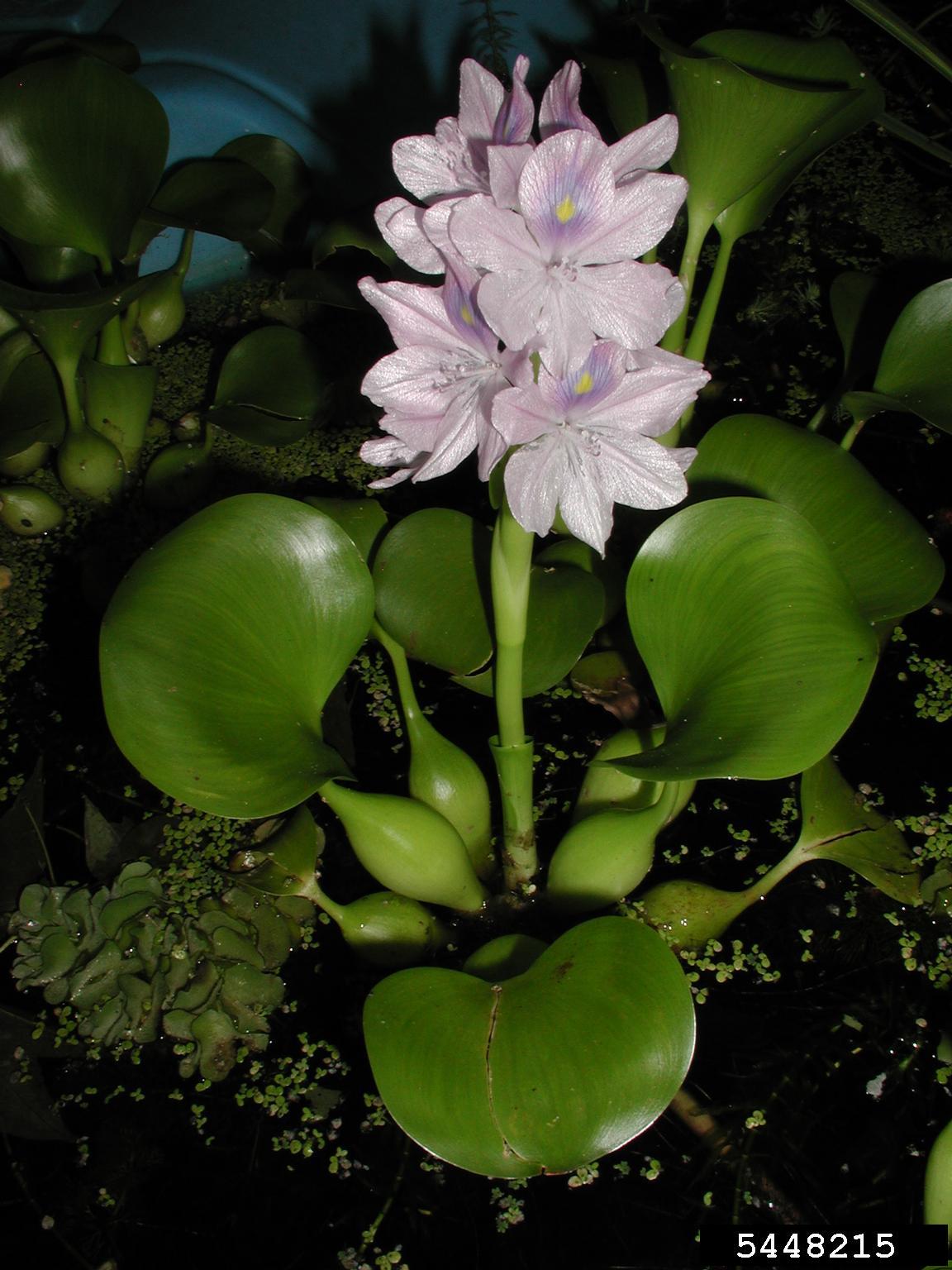 |
| waterhyacinth |
 |
| zebra mussels |
Invasive aquatic plants, used as water garden and aquarium decorations, aquarium fish, bait fish and fishing worms should never be dumped or “released” into any stream, lake, river or other water body. Invasive aquatic plants, can infest slow moving water such as ponds, lakes, swamps, irrigation canals, or ornamental ponds. Dense populations of invasive plants can clog waterways, which makes fishing, swimming and boating difficult. Thick colonies cover the surface of the water, preventing air from reaching it. This reduces the amount of oxygen in the water, which fish and other organisms need to survive. These dense mats of invasive aquatic vegetation can also prevent animals from getting to the water, and may crowd or shade out native plants, which other organisms depend upon for food or shelter.
Many invasive aquatic plants continue to be sold through aquarium and pond supply dealers, both online and in retail garden centers.
New introductions are probably the result of the improper disposal of ornamental pond plants or water, or when ponds adjacent to local water bodies overflow with winter rains.
Best Management Practices for Boat Cleaning
For those using lakes, ponds and streams follow these BMPs to limit introduction of aquatic invasives.
Drain
- Drain every conceivable space or item that can hold water.
- Follow factory guidelines for eliminating water from engines. All engines hold water, and jet drives on personal watercraft and other boats can hold extra water.
- Remove the drain plug from boats and put boat on an incline so that the water drains out.
- Drain live-wells, bilge, ballast tanks and transom wells on land.
- Empty water out of kayaks, canoes, rafts, etc.
Clean
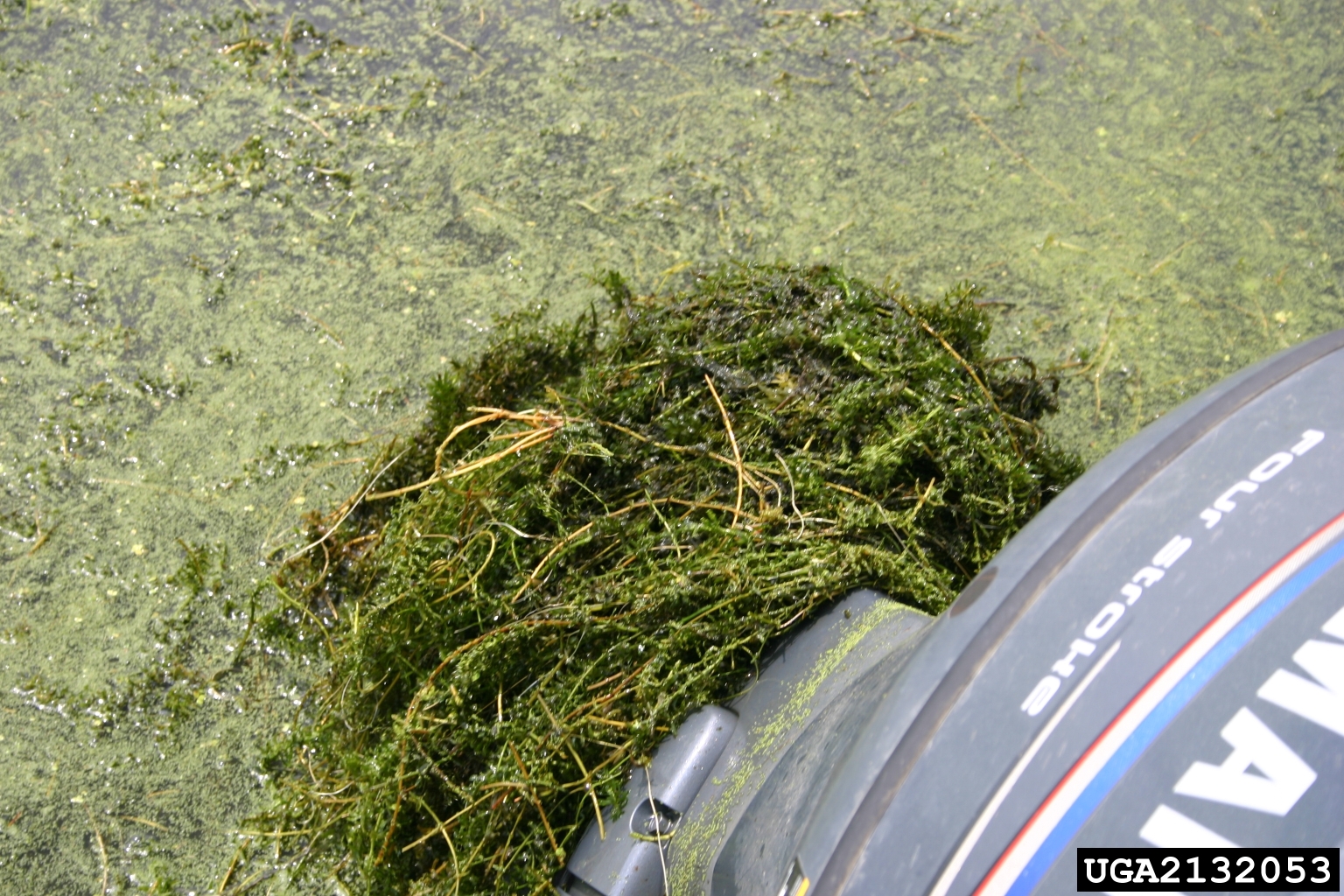 |
| Boat motor with hydrilla wrapped in the propeller |
- Remove any visible plant or plant fragments as well as mud or other debris. Plant material, mud and other debris routinely contain other organisms that may be an aquatic nuisance species. Some plant species are aquatic nuisance species.
- Check trailer, including axle, fender and wheel areas - in and around the boat itself: anchor, props and jet engines, ropes, boat bumpers, paddles.
- Clean and check and dry off all parts and equipment that came in contact with water.
- Empty bait buckets into trash. Do not empty any bait fish into the lake or reservoir.
- Using a car wash or home power water sprayer is not adequate to kill and/or remove zebra or quagga mussels. Carefully inspect after washing and remove any remaining mussels.
Dry
- Allow boat and trailer to completely dry before launching into another body of water.
Never Release Exotic Pets into the Wild
 |
| Captured python |
The greatest pathway by which non-native fish and wildlife species find their way into native habitats is through escape or release by pet owners. Burmese pythons, now established throughout south Florida and the Everglades, feed on native mammals and birds. Recent studies have found dramatic reductions in small mammal populations in Everglades National Park as python populations have increased. Nile monitor lizards in south Florida pose a threat to the Florida burrowing owl, which is a protected species. These are just a few of the many examples of non-native species that have escaped or been released from their owners.
Feral Hogs (Wild Pigs)
 |
| Damage by feral pigs |
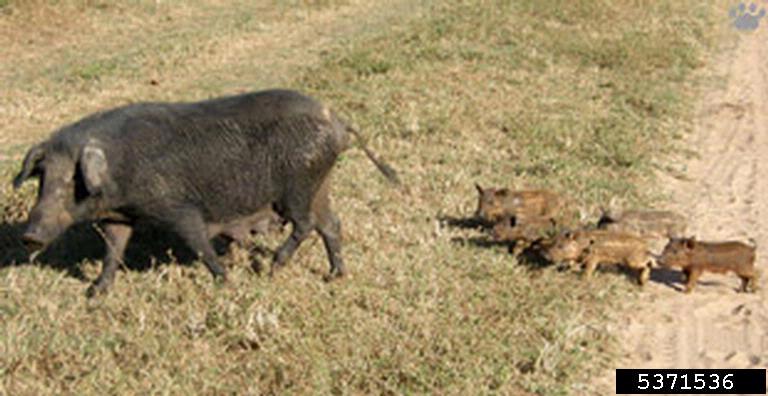 |
| Feral sow and piglets |
European wild boar, feral hogs, and crossbreeds of the two can be found in the wild. Feral hogs are domestic hogs that either escaped or were released for hunting. Within a few generations they develop the traits needed for survival in the wild.
Feral hogs continue to grow in numbers. Because of their destructive feeding habits and potential to spread disease, feral hogs are a substantial liability to agriculture; native wildlife and natural areas. However, these animals are also sought for recreational hunting and commercial harvest. Adult feral hogs can weigh from 110 to 770 lbs. Females can give birth to litters of 1 –12 piglets beginning at about 9 months of age. Life span in the wild is usually about 10 years, but feral hogs have been recorded living as long as 27 years. Feral hogs are indiscriminate omnivores which allows them to survive across a wide range of habitats, limited only by scarcity of water and severely cold temperatures. They are considered to be intelligent and can be very aggressive when threatened. Humans are the main predator of mature feral hogs.
Trapping and hunting are the main forms of control.
Online Resources
General Invasive Species Information
Firewood
Forest Pest Information
Invasive Species Mapping
A Field Guide for the Identification of Invasive Plants in Southern Forests
http://wiki.bugwood.org/Archive:IPSF
A Management Guide for Invasive Plants in Southern Forests
http://wiki.bugwood.org/Archive:MGIPSF
National Association of Exotic Pest Plant Councils
Center for Invasive Plant Management
Archived at msuinvasiveplants.org
National Park Service Weeds Gone Wild
Archived on www.invasive.org
National Invasive Species Information Center
The National Invasive Species Council
USDA Forest Service Invasive Species Program
U.S. Fish and Wildlife Service Invasive Species
Fire Management and Invasive Plants: A Handbook
www.fws.gov/invasives/pdfs/USFWS_FireMgtAndInvasivesPlants_A_Handbook.pdf
Fire Effects Information – Invasive Plants
www.fs.fed.us/database/feis/plants/weed/weedpage.html
Invasive Plant Responses to Silvicultural Practices in the South
www.invasive.org/silvicsforinvasives.pdf
A landowner’s Guide for Wild Pig Management – Practical Methods for Wild Pig Control
www.aces.edu/pubs/docs/A/ANR-1397/ANR-1397.pdf

